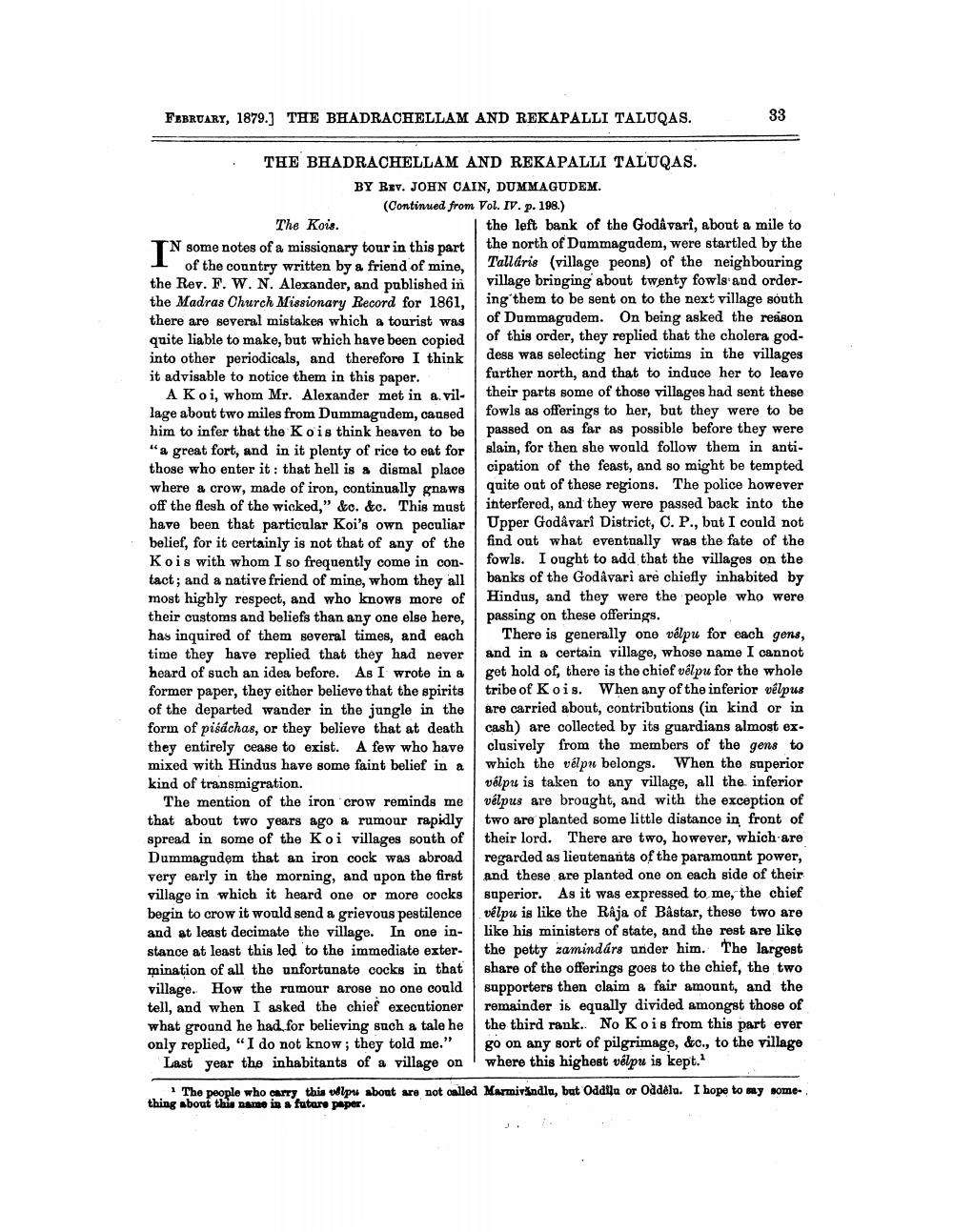________________
FEBRUARY, 1879.] THE BHADRACHELLAM AND REKAPALLI TALUQAS.
THE BHADRACHELLAM AND REKAPALLI TALUQAS. BY REV. JOHN CAIN, DUMMAGUDEM. (Continued from Vol. IV. p. 198.)
The Kois.
IN some notes of a missionary tour in this part of the country written by a friend of mine, the Rev. F. W. N. Alexander, and published in the Madras Church Missionary Record for 1861, there are several mistakes which a tourist was quite liable to make, but which have been copied into other periodicals, and therefore I think it advisable to notice them in this paper.
A Koi, whom Mr. Alexander met in a.village about two miles from Dummagudem, caused him to infer that the Ko is think heaven to be "a great fort, and in it plenty of rice to eat for those who enter it: that hell is a dismal place where a crow, made of iron, continually gnaws off the flesh of the wicked," &c. &c. This must have been that particular Koi's own peculiar belief, for it certainly is not that of any of the Kois with whom I so frequently come in contact; and a native friend of mine, whom they all most highly respect, and who knows more of their customs and beliefs than any one else here, has inquired of them several times, and each time they have replied that they had never heard of such an idea before. As I wrote in a former paper, they either believe that the spirits of the departed wander in the jungle in the form of pisáchas, or they believe that at death they entirely cease to exist. A few who have mixed with Hindus have some faint belief in a kind of transmigration.
The mention of the iron crow reminds me that about two years ago a rumour rapidly spread in some of the Koi villages south of Dummagudem that an iron cock was abroad very early in the morning, and upon the first village in which it heard one or more cocks begin to crow it would send a grievous pestilence and at least decimate the village. In one instance at least this led to the immediate extermination of all the unfortunate cocks in that village. How the rumour arose no one could tell, and when I asked the chief executioner what ground he had for believing such a tale he only replied, "I do not know; they told me."
Last year the inhabitants of a village on
33
the left bank of the Godavari, about a mile to the north of Dummagudem, were startled by the Talláris (village peons) of the neighbouring village bringing about twenty fowls and ordering them to be sent on to the next village south of Dummagudem. On being asked the reason of this order, they replied that the cholera goddess was selecting her victims in the villages further north, and that to induce her to leave their parts some of those villages had sent these fowls as offerings to her, but they were to be passed on as far as possible before they were slain, for then she would follow them in anticipation of the feast, and so might be tempted quite out of these regions. The police however interfered, and they were passed back into the Upper Godavari District, C. P., but I could not find out what eventually was the fate of the fowls. I ought to add that the villages on the banks of the Godavari are chiefly inhabited by Hindus, and they were the people who were passing on these offerings.
There is generally one vélpu for each gens, and in a certain village, whose name I cannot get hold of, there is the chief vélpu for the whole tribe of Kois. When any of the inferior velpus are carried about, contributions (in kind or in cash) are collected by its guardians almost exclusively from the members of the gens to which the velpu belongs. When the superior vélpu is taken to any village, all the inferior vélpus are brought, and with the exception of two are planted some little distance in front of their lord. There are two, however, which are regarded as lieutenants of the paramount power, and these are planted one on each side of their superior. As it was expressed to me, the chief vélpu is like the Raja of Bastar, these two are like his ministers of state, and the rest are like the petty zamindars under him. The largest share of the offerings goes to the chief, the two supporters then claim a fair amount, and the remainder is equally divided amongst those of the third rank.. No Kois from this part ever go on any sort of pilgrimage, &c., to the village where this highest vélpu is kept.'
The people who carry this velpu about are not called Marmivandlu, but Oddílu or Oddělu. I hope to say something about this name in a future paper.




